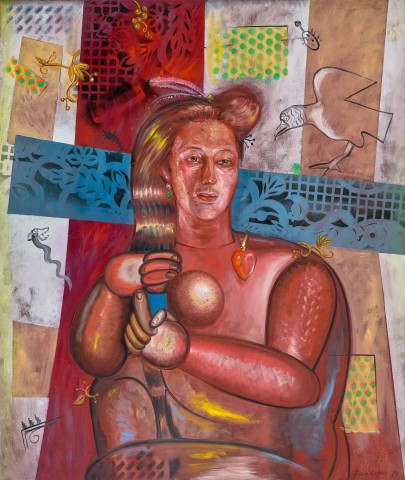UNTITLED, 1994
JUAN DAVILA
oil on canvas
101.5 x 86.5 cm
signed and dated lower right: Juan Leger 94
signed and dated verso: JUAN DAVILA 1994.
Tolarno Galleries, Melbourne
Private collection, Melbourne, acquired from the above in 1994
Christie’s, Melbourne, 25 June 2002, lot 31
The Cbus Collection of Australian Art, Melbourne, acquired from the above
3-D Semblance, Tolarno Galleries, Melbourne, February 1994
on long term loan to Gippsland Art Gallery, Victoria
Nainby, B., Stanhope, Z., and Furlonger, K., The Cbus Collection of Australian Art, in association with Latrobe Regional Gallery, Melbourne, 2009, pp. 19, 166 (illus.), 216
After fleeing the Pinochet regime in his native Chile, Juan Davila arrived in Australia in 1974, and had an almost immediate impact on the Australian art world with his distinctive, hard-hitting and politically focused work that unflinchingly brought to the fore complex issues around identity, race, gender and sexuality. As is now well known, Davila’s notoriety reached a crescendo in 1982 with the impounding of his large-scale mural Stupid as a Painter, 1981 – 82 by the NSW Vice Squad after complaints received by the conservative religious organisation the Festival of Light, spearheaded by its leader and NSW Parliamentarian, the Reverend Fred Nile.1
Yet this significant and deeply troubling event in no way curbed Davila’s desire to slaughter the ‘sacred cows’ of Australia’s art history and national myths. Since that time, his astute and biting appropriation of the imagery of European, North and South American and Australian artists in his work has seen him become one of this country’s most instantly recognisable and celebrated postmodern artists. Steadfastly committed to figuration, and to painting, as it has gone in and out of favour, Davila’s work reminds us of the capacity of art to speak to power, and of its ability to challenge societal injustice and prejudice. Tellingly, in recent years, he has increasingly turned his caustic gaze to the ongoing traumatic legacy of Australia’s colonisation and to our unconscionable treatment of asylum seekers and refugees.
Untitled, 1944 Is one of several Davila paintings of the 1990s based on French artist Fernand Léger’s iconic Nude on a Red Background, 1927. In each iteration, Davila reworks the blocky forms, articulated limbs and singular orb-like breast of Léger’s sitter, recreating her in a number of different guises. Set against a decorative background reminiscent of the patterns and colours of South American textiles, the subject of Davila’s Untitled is gender fluid, impassive, and defiant. Authorship of the painting is also characteristically thrown into question by the artist’s enigmatic signature, ‘‘Juan Léger”. As Elizabeth Ann Macgregor has noted: ‘Davila forces us to consider the question of what we want from artists today. He gives us a comprehensive answer: provocative, probing, witty, uncomfortable, unpalatable work which nonetheless aspires to a level of aesthetic pleasure – beauty even: work that cannot be forgotten and which leaves a lingering sense of unease, disturbing our world view at a time when dissent has become increasingly unacceptable. No-one escapes Davila’s excoriating gaze.’2
1. History repeated itself in 2019 when the Australian Christian Lobby called for the removal of Davila’s work Holy Family from the exhibition The Abyss at Griffith University Art Museum in Brisbane. The work remained on show.
2. Macgregor, E., Juan Davila, The Miegunyah Press, Carlton in association with the Museum of Contemporary Art, Sydney, 2006, p. vii
KELLY GELLATLY
